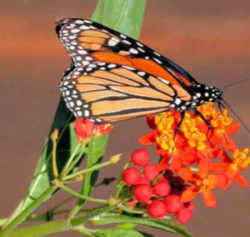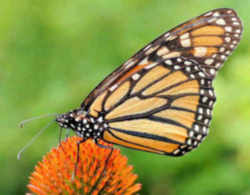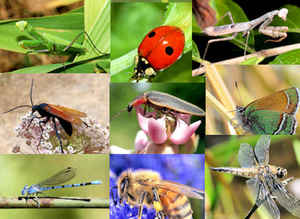
Texas Symbols
Texas State Insect
Monarch Butterfly

(Danaus plexippus)
Adopted on June 6, 1995.
The Monarch Butterfly, (Danaus plexippus,) became the Texas state insect by a 1995 resolution of the state legislature. The resolution was introduced by Representative Arlene Wohlgemuth on behalf of students in her district. It was adopted on June 6, 1995.
Did you know that: The Monarch Butterfly has been proclaimed the official state insect or butterfly in each of the following states:
Alabama | Idaho | Illinois | Minnesota
Texas | Vermont | West Virginia
Texas State Butterfly: Monarch Butterfly

The monarch butterfly is sometimes called the "milkweed butterfly" because its larvae eat the plant. In fact, milkweed is the only thing the larvae can eat! If you'd like to attract monarchs to your garden, you can try planting milkweed (if you live in the right area).
Entomologists divide the migrating populations of Monarch Butterflies into two groups, one west of the continental divide which is considered too high for the butterflies to fly over, and all the territory eastward including Florida. The eastern and western migrating Monarch undergoes a chemical change delaying sexual maturity, allowing the butterflies to wait out the winter in large colonies south of the freeze line which have been found in Mexico and California. They only mate when they return north, living as long as nine months in the process.
Characteristics of the Monarch Butterfly
In Spring when the female butterflies migrate northward, they lay eggs on various species of milkweed. The development period from the egg through larva and chrysalis to the adult ranges from 20 to 33 days. The development time depends on temperature (faster in warmer areas). Some monarchs remain in the vicinity of their breeding grounds; others fly north to lay eggs. Some monarchs remain in the vicinity of their breeding grounds; others fly north to lay eggs.
The development period from the egg through larva and chrysalis to the adult ranges from 20 to 33 days. The development time depends on temperature (faster in warmer areas).
The larvae feed on the plant leaves for about two weeks and develop into caterpillars about 2 inches long.
After awhile, the caterpillars attach themselves head down to a convenient twig, they shed their outer skin and begin the transformation into a pupa (or chrysalis), a process which is completed in a matter of hours.
The pupa resembles a waxy, jade vase and becomes increasingly transparent as the process progresses. The caterpillar completes the miraculous transformation into a beautiful adult butterfly in about two weeks.
The butterfly finally emerges from the now transparent chrysalis. It inflates its wings with a pool of blood it has stored in its abdomen. When this is done, the monarch expels any excess fluid and rests.
The butterfly waits until its wings stiffen and dry before it flies away to start the cycle of life all over again.
Eastern populations winter in Florida, along the coast of Texas, and in Mexico, and return to the north in spring. Monarch butterflies follow the same migration patterns every year. During migration, huge numbers of butterflies can be seen gathered together.
Most predators have learned that the monarch butterfly makes a poisonous snack. The toxins from the monarch's milkweed diet have given the butterfly this defense. In either the caterpillar or butterfly stage the monarch needs no camouflage because it takes in toxins from the milkweed and is poisonous to predators. Many animals advertise their poisonous nature with bright colors... just like the monarch!
Texas HOUSE CONCURRENT RESOLUTION
HOUSE CONCURRENT RESOLUTION
By Wohlgemuth, Hunter of Taylor, Patterson
H.C.R. No. 94 74R6105 KMP-D
WHEREAS, The State of Texas has traditionally recognized a variety of official state symbols that embody the proud spirit and rich heritage of our
state; and
WHEREAS, The bluebonnet, the Guadalupe bass, and the mockingbird are examples of natural specimens that serve to symbolize the great diversity of the
Texas landscape, while the state dish, chili, fittingly represents another aspect of our shared culture as Texans; and
WHEREAS, In keeping with this custom, the designation of the monarch butterfly as the official State Insect of Texas will provide suitable recognition
for this regal inhabitant of the Lone Star State; and
WHEREAS, The monarch butterfly, known to scientists as "Danaus plexippus," is a familiar and thrilling sight to Texans who play host to this
beautiful insect each year as it travels southward toward the equator; its distinctive rust-colored wings, marked by black veins and two rows of white
spots, make the monarch butterfly instantly recognizable to all; and
WHEREAS, This stately creature is also renowned for its unique ability to evade predators; its main source of nourishment, the milkweed plant, contains
a form of poison that makes the monarch butterfly unpalatable to birds and other hungry critters; and
WHEREAS, Like Texas, the monarch butterfly has inspired imitators but remains in a league all its own; the viceroy butterfly, whose wings closely resemble
those of the monarch, manages to avoid being eaten by relying on the reputation of its more deadly cousin; and
WHEREAS, One of the heartiest and most resolute members of the insect kingdom, the monarch butterfly migrates nearly 2,000 miles southward each year
in its quest to find a warmer home for the winter, descending on the State of Texas for one last rest and feeding before it embarks on the final leg
of its journey to the mountains of Mexico; and
WHEREAS, The Lone Star State also holds the distinction of being the birthplace of this imperial insect; each spring the skies over Texas are filled
with excitement and color as many thousands of these tiny creatures return to the site of their own nativity to give birth to a new generation; and
WHEREAS, Recognizing this butterfly's great affinity for our state, the National Monarch Project has designated the Abilene Zoological Gardens as the
first official sanctuary along the eastern migration path, and Texans everywhere can take immense pride in the special tie that we share with this
magnificent creature; and
WHEREAS, The monarch butterfly is as beautiful and memorable as a Texas sunset, soaring above all other insects in its nobility and determination,
and its unique relationship with Texas makes it a truly appropriate symbol of the majestic spirit of the Lone Star State; now, therefore, be it
RESOLVED, That the 74th Legislature of the State of Texas hereby designate the monarch butterfly as the official State Insect of Texas.
Texas Law
The monarch butterfly was named the official insect of the State of Texas by House Concurrent Resolution and is not, therefore,
listed in the Texas Statutes.
Only a few of Texas' myriad symbols were actually adopted by an act of the legislature and written into the Texas Statutes.
Taxonomic Hierarchy: Monarch Butterfly
Kingdom: Animalia (Animals)
Phylum: Arthropoda (Arthropods)
Subphylum: Hexapoda (Hexapods)
Class: Insecta (Insects)
Order: Lepidoptera (Butterflies and Moths)
Superfamily: Papilionoidea (Butterflies and Skippers)
Family: Nymphalidae (Brush-footed Butterflies)
Subfamily: Danainae (Milkweed Butterflies & Glasswings)
Tribe: Danaini (Milkweed Butterflies)
Genus: Danaus
Species: plexippus (Monarch - Hodges#4614)
Butterflies, and Bugs







